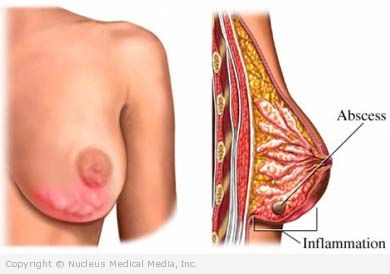(Breast Infection)
Mastitis – Definition
Mastitis is painful swelling and redness in the breast. It is especially common among women who are breastfeeding. While it is most common in just one breast it can occur in both.
Mastitis – Causes
Mastitis is often caused by trapped breast milk in a milk duct. The trapped breast milk can irritate the tissue around it and cause swelling and pain.
Mastitis can also be caused by a bacterial infection in the breast tissue. Milk ducts or cracked skin around the nipple can allow bacteria to enter the breast and cause an infection.
Mastitis often occurs during breastfeeding but, it is possible to get mastitis at other times. This article will focus on symptoms and treatment of lactation-associated mastitis.
Mastitis – Risk Factors
A risk factor is something that increases your chance of getting a disease or condition.
Risk factors include:
- Previous mastitis
- Abrasion or cracking of the breast nipple
- Wearing a bra or clothing that is too tight
- Missed breastfeeding (causing overdistention of the breast)
- Irregular breastfeeding
- Pressure on the breasts, caused by:
- Sleeping on the stomach
- Holding the breast too tightly during feeding
- Baby sleeping on the breast
- Exercising (especially running) without a support bra
- Anything that causes too much milk to remain in the breast, including:
- Baby’s teething
- Use of artificial nipple or pacifier
- Incorrect positioning of the baby during feedings
- Abrupt weaning
- Yeast infection of the breast
- Low resistance to infection or immune deficiency disorder
- Psoriasis or other skin conditions that affect the nipple
- Diabetes mellitus
- Rheumatoid arthritis
- Use of cortisone drugs
- Prior breast surgery or implants
- Smoking
Mastitis – Symptoms
Symptoms may include:
- Fever
- Fatigue
- Nausea or vomiting
- Aches, chills, or other flu-like symptoms
- Redness, tenderness, or swelling of the breast
- A burning feeling in the breast
- A hard feeling or tender lump in the breast
- Pus draining from the nipple
- Swollen lymph glands in the armpit or above the collar bones
Mastitis – Diagnosis
Your doctor will ask about your symptoms and medical history. A physical exam of your breast will also be done. If the diagnosis is uncertain, or if mastitis recurs, your doctor may order the following tests:
- A culture of your breast milk or nipple discharge
- A biopsy of the affected area
- A breast ultrasound
- A mammogram or x-ray of the breast
Mastitis – Treatment
Treatment may include:
Methods to Clear Blocked Breast Ducts
Relieving the blockage in the milk duct is an effective way to decrease the pain and swelling. To clear blocked breast ducts try:
- Breastfeeding frequently — Breastfeeding with mastitis is not harmful to the baby. Talk to your doctor if you are also taking medicines though, to make sure the medicines are not harmful to your baby.
- Offering the baby the infected breast first (to promote complete emptying of infected breast)
- Using a breast pump to express milk
- Applying warm compresses to breasts prior to feeding (to stimulate milk ejection reflex)
Pain Relief
To reduce pain and swelling in the breast:
- Apply ice compresses to the affected area of your breast after breastfeeding.
- If your mastitis is not caused by breastfeeding, consider using over-the-counter pain relievers as recommended by your doctor.
- Be sure to ask your doctor what pain relievers are safe for you and your baby. Taking aspirin is not advised during pregnancy or breastfeeding.
- Drink lots of fluids.
- Get plenty of rest.
Medication
Antibiotics may be used to treat the infection. They may help cure the infection or reduce the risk of more serious but rare complications such as blood infection. If you are breastfeeding, talk to your doctor about which antibiotics are best for you to take so you can continue to breastfeed.
The bacteria known as Staphylococcus aureus is responsible for many cases of bacterial mastitis. In recent years some forms of “staph” have become resistant to many of the commonly used antibiotics. So far the resistant bacteria have been rare in cases of mastitis.
If mastitis does not respond to antibiotics, a localized collection of pus called an abscess might be present. This is usually treated with other antibiotics and a drainage procedure or surgery.
If you are diagnosed with mastitis, follow your doctor’s instructions.
Mastitis – Prevention
Strategies to help prevent mastitis include:
- Prevent engorgement of the breast with milk by:
- Frequent breastfeeding
- Use of breast pump
- Wash your hands and breast nipple before breastfeeding.
- Avoid wearing bras or clothing that is too tight.
- Avoid sleeping on your breasts, or allowing a baby to sleep on your breasts.
- If your nipples crack, apply lotion or cream as recommended by your doctor.

